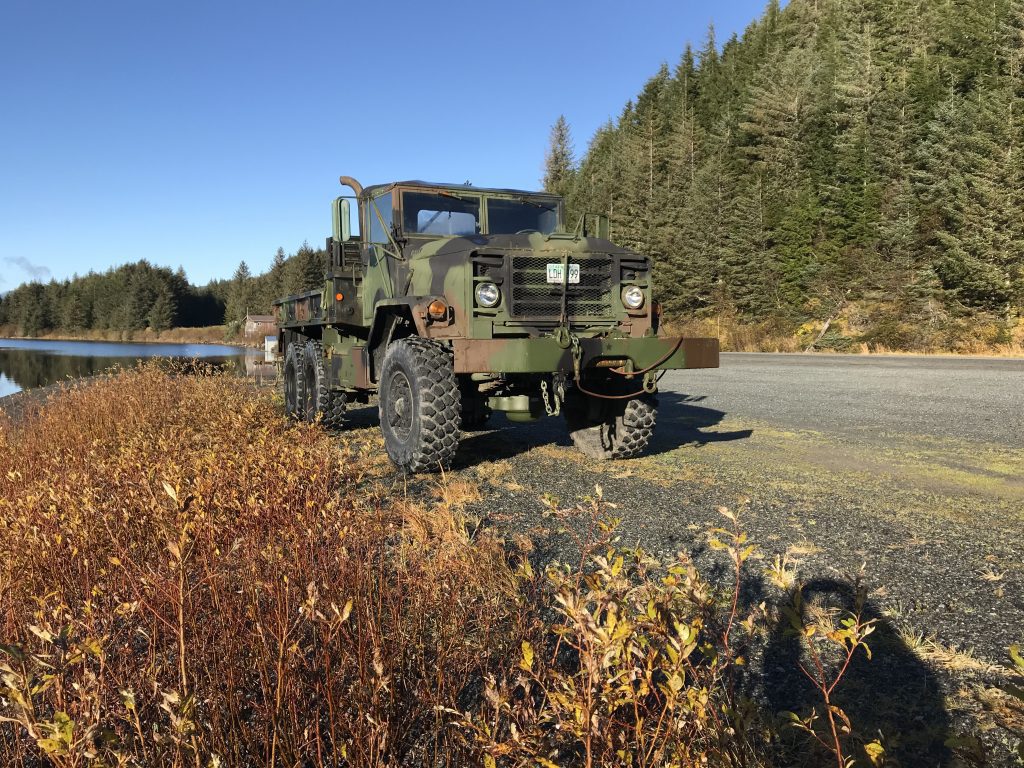
A few weeks ago, on my way out for a walk along Power Creek Road, I did a double take when passing a helicopter lifting supplies off the near end of the lakeside runway. Parked beside the chopper was a “deuce and a half” camouflaged in green, black, and brown.
While seeing heavy gear being lifted off that location enroute to various mountain-top telecommunications sites is not uncommon, the appearance of this classic military vehicle was.
The nickname for this famous 10-wheeled off-road truck, which was developed in the late 1940s, comes from its two-and-a-half-ton carrying capacity, and anyone who has served in the land-based branches of the military probably has had experiences with it.
In this case, it was being used by Copper Valley Telecom to haul batteries and various other heavy items to the airport for transportation to their sites.
The sight of this behemoth brought back a flood of memories, ironically involving communications.
Back in the fall of 1968, I was drafted into the Army. After basic training at Ft. Lewis in Washington and Radio Operator’s School in Ft. Ord, California, I was sent to Signal School at Ft. Gordon, Georgia in March of 1969. There we trained in long-range communications using teletype equipment, as well as message encryption techniques.
The final exam included a Field Training Exercise out in nearby swamps. I had lived in Cordova all my life, and was very familiar with the concept of rain, but let me tell you that two weeks out in the Georgia boonies made me realize what rain was really all about.
As it turns out, the mobile equipment we used was hauled around in what looked like a camper, mounted in the back of none other than a deuce and a half.
We ended up in a Joint Training Exercise with NATO troops from the Netherlands, pulling six-hour shifts around the clock establishing communication “nets.” Part of this required changing frequency every six hours, to theoretically baffle anyone trying to intercept our traffic.
Believe it or not, in those days changing frequency required literally changing the length of a long-wire antenna which was strung between two 40-foot poles that were assembled in sections and held in place by guy wires.
So. It’s midnight in rainy Georgie, I’m crammed in a little camper stuffed wall-to-wall with radio and teletype gear, and my partner is a huge red-headed Dutch trooper.
It was time to change frequency, and then come back up on the “net”.
This entailed lowering the antenna, clipping it to a new length, and then raising it back up, using a simple pulley system attached to the support poles.
Donning helmets and ponchos, we grabbed red night-vision flashlights and stepped out into a pitch-black downpour. I told my partner to lower his end, I would lower my end, clip the wire to the new length, and then holler at him to raise the wire back up.
I lowered my end of the antenna and stood waiting for the other end to come down on the ground. It seemed to be taking considerable time.
Then I heard a sound I will never forget. A whishing sound that seemed to accelerate.
I realized what it was and dared not move. My partner had gone around and carefully undone all the guy wires that held up the antenna pole on his end.
It crashed down inches away, amidst a tangle of wires.
Communication is the key to success, and we were training in communication. Yet I did not realize he did not understand English very well.
I vaguely recall yelling several words in a language that evidently passed the Universal Language Test, for he came running over to see if I was OK.
With our antenna system in shambles, there was nothing we could do, so we headed back inside our hut. I knew what was coming next.
A Master Sergeant came roaring up in a jeep. We piled out of the hut. He stood us by the deuce and a half and gave us a classic lesson in communications that I will never forget.
Believe me, it was not sent in the Morse Code dits and dahs we had memorized at Ft. Ord, and it did not have to be decoded.
Most of it was directed at PFC Shellhorn. Rightly so. It was my communication skills that were the cause of this mess.
So here I am, 54 years later, on a sunny fall day, taking photos of this deuce and a half by the lake on my iPhone, to send to my computer, so I could write this story and send it to the Cordova Times with a tap of my fingers.
It dawned on me just how advanced and dependent we are on technology all these years later – and how accessible worldwide communication is.
The messages get out with incredible speeds and ease.
But saying the right words is still the most important thing.





